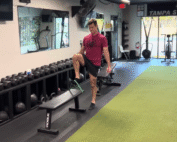Optimism for a new you: exercise science shows glass is half full
Let’s be honest, changing your habits is hard work! For many, the change seems impossible. There is no denying that starting the journey towards health and fitness is difficult.
For many, exercise is difficult and thus they don’t want to commit the time to doing it on a regular basis. On top of that changing eating habits is even harder!
There are an infinite amount of reasons why adopting a healthy lifestyle is hard:
“I don’t have the time”
“I don’t know what to do”
“I don’t feel like working out after work or getting up early before”
“I have bad genetics”
“I’m going to start next year”
“I’m too old”
“Healthy food tastes terrible!”
The list goes on and on. Because there is never a “right” time to start, there is no reason to wait. You do have the time. The time to start is NOW!
There is an abundance of free online information, and many health and fitness professionals to talk to and work with. There are individuals who exercise into their 80’s, 90’s, and beyond. However, if you keep searching for an excuse you will always find one.
Yet, here are a few new discoveries in the field of exercise science that should provide optimism towards starting your health and fitness journey.
The quote above demonstrates that your body is always adapting and changing. Your body will respond to your training and you will see benefits if you correctly follow a plan and stay consistent.
Building on that quote the following excerpt explains that your body and tissues adapt to what you do.
“Animal experiments have shown that immobilisation quickly leads to a dysregulation in fibre arrangement and to a multidirectional growth of additional cross links between dense collagen fibres. As a result, the fibres lose their elasticity as well as the smooth gliding motion against one another…Research has confirmed that previously optimistic assumption that proper exercise loading of the fibres, if applied regularly, can induce a more youthful collagen architecture.”
-Fascia in sport and movement
If you are active, your body and tissues can continue to be elastic allow you to move in a more youthful fashion.
This oversimplifies a complicated subject but shows that YOU have control over how your body adapts based on your actions. Your body will adapt to sitting for an entire day from the workplace, to the car, and to the couch. Your body will also adapt if you begin to exercise regularly.
“Exercise, including resistance training, can be considered a good form of stress called “eustress” that over time allows the human movement system to adapt and thus be able to maintain homeostatic states under a variety of conditions.”
-NASM Essentials of Personal Training
Science shows that your body makes positive adaptations to the “stress” that exercise causes. Your muscles and connective tissues respond positively. Exercise can improve cardiac function, hormonal balances, help prevent diabetes, decrease body fat, increase bone density, and more!
I hope this article shows that the glass is half full when it comes to starting a healthier lifestyle. Science is on your side! It is important to note that consistency is key for health. It takes time for your body to make the changes that you are looking for, but they are completely possible assuming that your goals are reasonable and attainable.
My advice is to play the long game, stay consistent, track your progress, and be kind to yourself. Recognize that it is HARD WORK to maintain a healthy lifestyle so give yourself a pat on the back for make positive changes towards a healthy lifestyle!
If you have any questions or are interested in getting advice from a fitness professional please contact us and we will gladly help you out in your goal towards a healthier lifestyle!
Email: john@tampastrength.com or shawn@tampastrength.com
IG: @tampastrength @the_krack3n
Facebook: Tampa Strength Academy
Sources
-Dr. Andreo Spina, “Discussing mobility longevity, connective tissue remodelling, and movement”.Youtube. Youtube, 19 November 2013. Web. 2 March 2017.
-Schleip, Robert, and Werner Klinger. “Chapter 1.” Fascia in Sport and Movement. Edinburgh: Handspring, 2015. 7. Print.
-Clark, Micheal, Brian G. Sutton, and Scott Lucett. “Chapter 13.” NASM Essentials of Personal Fitness Training. Burlington, MA: Jones & Bartlett Learning, 2014. 304. Print.








